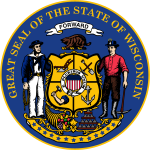| ||||||||||||||||||||||||||
| ||||||||||||||||||||||||||
 County Results
| ||||||||||||||||||||||||||
| ||||||||||||||||||||||||||
| Elections in Wisconsin |
|---|
 |
The 1956 United States presidential election in Wisconsin was held on November 6, 1956 as part of the 1956 United States presidential election. State voters chose 12 electors to the Electoral College, who voted for president and vice president.
Politics in Wisconsin since the Populist movement had been dominated by the Republican Party.[2] The Democratic Party became uncompetitive away from the Lake Michigan coast as the upper classes, along with the majority of workers who followed them, fled from William Jennings Bryan's agrarian and free silver sympathies.[3] Although the state did develop a strong Socialist Party to provide opposition to the GOP, Wisconsin developed the direct Republican primary in 1903 and this ultimately created competition between the "League" under Robert M. La Follette, and the conservative "Regular" faction.[4] This ultimately would develop into the Wisconsin Progressive Party in the late 1930s, which was opposed to the conservative German Democrats and to the national Republican Party, and allied with Franklin D. Roosevelt at the federal level.
During the two wartime elections, the formerly Democratic German counties in the east of the state – which had been powerfully opposed to the Civil War because they saw it as a "Yankee" war and opposed the military draft instituted during it[5] – viewed Communism as a much greater threat to America than Nazism and consequently opposed President Roosevelt's war effort.[6] Consequently, these historically Democratic counties became virtually the most Republican in the entire state, and became a major support base for populist conservative Senator Joe McCarthy, who became notorious for his investigations into Communists inside the American government. The state's populace's opposition to Communism and the Korean War turned Wisconsin strongly to Republican nominee Dwight D. Eisenhower in the 1952 presidential election.
For the 1956 rematch, Democratic nominee Adlai Stevenson II began by campaigning against Eisenhower's handling of farm problems, at a time when most of the interior United States was suffering from a severe drought.[7] The Democrat would then attack Eisenhower as a "weak" President when the two were touring the Midwest during September.[8]
Early polls showed Eisenhower leading the state despite farm unrest, owing to the unpopularity of Stevenson.[9] No later poll was taken, but evidence was that state's farmers were not trending to Stevenson at all, and that the Suez Crisis would hurt rather than help Stevenson.[10]
- ^ "The Presidents". David Leip. Retrieved September 27, 2017.
Eisenhower's home state for the 1956 Election was Pennsylvania
- ^ Burnham, Walter Dean. "The System of 1896: An Analysis". The Evolution of American Electoral Systems. pp. 178–179. ISBN 0313213798.
- ^ Sundquist, James. Politics and Policy: The Eisenhower, Kennedy, and Johnson Years. p. 526. ISBN 0815719094.
- ^ Hansen, John Mark; Shigeo, Hirano; Snyder jr, James M. "Parties within Parties: Parties, Factions, and Coordinated Politics, 1900-1980". In Gerber, Alan S.; Schickler, Eric (eds.). Governing in a Polarized Age: Elections, Parties, and Political Representation in America. pp. 165–168. ISBN 978-1-107-09509-0.
- ^ Phillips, Kevin P. The Emerging Republican Majority. pp. 381–382, 414. ISBN 978-0-691-16324-6.
- ^ Phillips. The Emerging Republican Majority, pp. 387-388
- ^ Blair, William M. (August 30, 1956). "Stevenson Asserts G.O.P. Fosters Farm Depression: Broken Promises Charged Stevenson Urges Action Stevenson Accuses Republicans of Fostering a Farm Depression — 3 States Are Pivotal". The New York Times. p. 1.
- ^ Salisbury, Harrison E. (September 27, 1956). "Stevenson Says Eisenhower Fails to Lead Country: In Kansas City, He Asserts the Question Is, "Who's in Charge Here?" Decries Farm Policy: Nominee Charges That the President Defaulted on 90% Parity Pledgeedition=Special to The New York Times". The New York Times. p. 1.
- ^ White, William S. (October 1, 1956). "G.O.P. Retaining Wisconsin Lead; Democrats Gain: Survey Shows Farm Unrest and Spotty Unemployment Are Having Influence". The New York Times (Special to The New York Times ed.). p. 1.
- ^ King, Seth H. (November 1, 1956). "Major Farm Vote Still Republican: Democrats Fail to Stir Big Revolt – May Lose Votes on Crisis in Mideast". The New York Times. p. 44.
Cite error: There are <ref group=lower-alpha> tags or {{efn}} templates on this page, but the references will not show without a {{reflist|group=lower-alpha}} template or {{notelist}} template (see the help page).
© MMXXIII Rich X Search. We shall prevail. All rights reserved. Rich X Search


